 W
WThe ancient Roman city of Pompeii has been frequently featured in literature and popular culture since its modern rediscovery. Pompeii was buried under 4 to 6 m of volcanic ash and pumice in the eruption of Mount Vesuvius in AD 79.
 W
W79 A.D. is a 1962 Italian-French epic drama film written and directed by Gianfranco Parolini and starring Brad Harris.
 W
WApocalypse Pompeii is a 2014 American disaster film produced by The Asylum and directed by Ben Demaree. The film stars Adrian Paul, Jhey Castles, John Rhys-Davies, Dylan Vox, Dan Cade. It was filmed in Sofia, Bulgaria, and Pompeii, Italy.
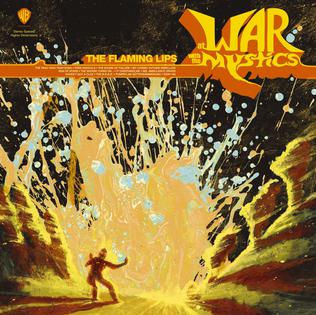 W
WAt War with the Mystics is the eleventh studio album by American rock band the Flaming Lips, released on April 3, 2006 by Warner Bros. Records. The album is more guitar-driven and features more politically themed lyrics than the band's previous two albums The Soft Bulletin (1999) and Yoshimi Battles the Pink Robots (2002).
 W
WThe Cambridge Latin Course (CLC) is a series of textbooks published by Cambridge University Press, used to teach Latin to secondary school students. First published in 1970, the series is in its fifth edition as of April 2019. It has reached high status in the United Kingdom, being the most successful Latin course in the country and used by 85% of Latin-teaching schools.
 W
W"Cities in Dust" is a song by English rock band Siouxsie and the Banshees from their seventh studio album, Tinderbox (1986). It was released on 18 October 1985 as the album's lead single.
 W
WCurse of the Faceless Man is a 1958 independently made American low-budget black-and-white horror film, produced by Robert E. Kent, directed by Edward L. Cahn, that stars Richard Anderson, Elaine Edwards, Adele Mara, and Luis van Rooten. Science fiction writer Jerome Bixby wrote the screenplay. The film was theatrically released in the U.S. by United Artists as a double feature with It! The Terror from Beyond Space.
 W
WDelusion and Dream in Jensen's Gradiva is an essay written in 1907 by Sigmund Freud that subjects the novel Gradiva by Wilhelm Jensen, and especially its protagonist, to psychoanalysis.
 W
WThe Destruction of Pompeii and Herculaneum is a large 1822 painting by English artist John Martin. It follows the pattern set by his previous successful painting, Belshazzar's Feast, which was another depiction of a dramatic scene from history delivered from an esoteric point of view. The work evanesced from the Tate Gallery storerooms soon after it was damaged by the 1928 Thames flood, however it was rediscovered in 1973 and subsequently restored in 2011.
 W
WEscape from Pompeii is a shoot-the-chutes water attraction designed by Intamin located at Busch Gardens Williamsburg in Williamsburg, Virginia.
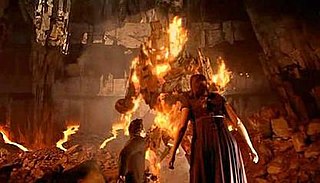 W
W"The Fires of Pompeii" is the second episode of the fourth series of the British science fiction television series Doctor Who. It was broadcast on BBC One on 12 April 2008. Set shortly before and during the eruption of Mount Vesuvius in AD 79, this episode depicts alien time traveller the Doctor and his new companion Donna Noble on a trip to Pompeii, where they uncover an alien invasion. Their clashing worldviews present an ethical dilemma for the Doctor.
 W
WThe Fires of Vulcan is a Big Finish Productions audio drama based on the long-running British science fiction television series Doctor Who.
 W
WGradiva is a novel by Wilhelm Jensen, first published in instalments from June 1 to July 20, 1902 in the Viennese newspaper "Neue Freie Presse". It was inspired by a Roman bas-relief of the same name and became the basis for Sigmund Freud's famous 1907 study Delusion and Dream in Jensen's Gradiva. Freud owned a copy of this bas-relief, which he had joyfully beheld in the Vatican Museums in 1907; it can be found on the wall of his study in 20 Maresfield Gardens, London – now the Freud Museum.
 W
WThe Last Day of Pompeii is a large history painting by Karl Bryullov produced in 1830–1833 on the subject of the eruption of Mount Vesuvius in AD 79. It is notable for its positioning between Neoclassicism, the predominant style in Russia at the time, and Romanticism as increasingly practised in France. The painting was received to near universal acclaim and made Bryullov the first Russian painter to have an international reputation. In Russia it was seen as proving that Russian art was as good as art practised in the rest of Europe. It inspired Edward Bulwer-Lytton's world famous novel The Last Days of Pompeii. Critics in France and Russia both noted, however, that the perfection of the classically modelled bodies seemed to be out of keeping with their desperate plight and the overall theme of the painting, which was a Romantic one of the sublime power of nature to destroy man's creations.
 W
WThe Last Days of Pompeii is a novel written by Edward Bulwer-Lytton in 1834. The novel was inspired by the painting The Last Day of Pompeii by the Russian painter Karl Briullov, which Bulwer-Lytton had seen in Milan. It culminates in the cataclysmic destruction of the city of Pompeii by the eruption of Mount Vesuvius in AD 79.
 W
WThe Last Days of Pompeii is a 1908 Italian silent historical film directed by Arturo Ambrosio and Luigi Maggi and starring Lydia De Roberti and Umberto Mozzato. It was loosely based on the novel of the same title by Edward Bulwer-Lytton. The film was a success on its release, and its popularity is credited with starting a fashion for epic historical films.
 W
WGli ultimi giorni di Pompei is a 1913 Italian black and white silent film directed by Mario Caserini and Eleuterio Rodolfi.
 W
WThe Last Days of Pompeii (1935) is an RKO Radio Pictures film starring Preston Foster and directed by Ernest B. Schoedsack and Merian C. Cooper, creators of the original King Kong. Although inspired by the novel of the same name by Edward Bulwer-Lytton, the film has virtually nothing to do with the book. Indeed, a Foreword appearing after the film's opening credits states, "Although ... the characters and plot have no relation to those in the novel by Sir Edward Bulwer-Lytton, acknowledgement is made of his description of Pompeii which has inspired the physical setting of this picture".
 W
WThe Last Days of Pompeii (1950) is a black and white French-Italian Peplum, directed by Marcel L'Herbier "in collaboration with" Paolo Moffa, who was also the director of production. It was adapted from Edward Bulwer-Lytton's novel The Last Days of Pompeii. The film has also been known as Sins of Pompeii.
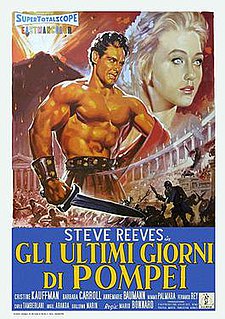 W
WThe Last Days of Pompeii is a 1959 Eastmancolor sword and sandal action film starring Steve Reeves, Christine Kaufmann, and Fernando Rey and directed by Mario Bonnard and Sergio Leone. Bonnard, the original director, fell ill on the first day of shooting, so Leone and the scriptwriters finished the film.
 W
WThe Last Days of Pompeii is an Italian-American 1984 television miniseries filmed at Pinewood Studios and broadcast on ABC-TV and Rai, adapting the 1834 novel of the same name by Edward Bulwer-Lytton. It was the second English-language adaptation of the book for film or television.
 W
WLEGO Pompeii is notable for being among the largest of all Lego historical models. Lego Pompeii was developed by Ryan McNaught of Melbourne, Australia, a notable Lego artist known as "The Brickman."
 W
WLive at Pompeii is a live album and film by David Gilmour, the former guitarist of Pink Floyd. It was recorded at the Amphitheatre of Pompeii. It documents his 2015–16 world tour to promote his album, Rattle That Lock (2015). The concert was directed by Gavin Elder. The album was released on 29 September 2017 and is available on CD, LP, digital download, DVD, BD and deluxe box set containing the CD album and BD, plus a bonus exclusive BD of extras.
 W
WPink Floyd: Live at Pompeii is a 1972 concert documentary film directed by Adrian Maben and featuring the English rock group Pink Floyd performing at the ancient Roman amphitheatre in Pompeii, Italy. Although the band perform a typical live set from the era, there is no audience beyond the basic film crew. The main footage in and around the amphitheatre was filmed over four days in October 1971, using the band's regular touring equipment, including a mobile 8-track recorder from Paris. Additional footage filmed in a Paris television studio the following December was added for the original 1972 release. The film was then re-released in 1974 with additional studio material of the band working on The Dark Side of the Moon, and interviews at Abbey Road Studios.
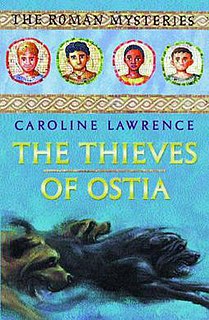 W
WThe Roman Mysteries is a series of historical novels for children by Caroline Lawrence. The first book, The Thieves of Ostia, was published in 2001, finishing with The Man from Pomegranate Street, published in 2009, and 17 more novels were planned, plus a number of "mini-mysteries", spin offs and companion titles.
 W
WPompei: The Legend of Vesuvius, also known as TimeScape: Journey to Pompeii, is a 2000 historical adventure game. The game was developed by Arxel Tribe and Réunion des Musées Nationaux, and published by Cryo Interactive. It is followed by a sequel, Jerusalem: The Three Roads to the Holy Land.
 W
WPompeii is a 2014 romantic historical disaster film produced and directed by Paul W. S. Anderson. An international co-production between the United States, Germany and Canada, it is inspired by and based on the eruption of Mount Vesuvius in 79 A.D. that destroyed Pompeii, a city of the Roman Empire. The film stars Kit Harington, Emily Browning, Carrie-Anne Moss, Adewale Akinnuoye-Agbaje, Jessica Lucas, with Jared Harris, and Kiefer Sutherland.
 W
WPompeii is a novel by Robert Harris, published by Random House in 2003. It blends historical fiction with the real-life eruption of Mount Vesuvius on 24 August 79 AD, which overwhelmed the town of Pompeii and its vicinity. The novel is notable for its references to various aspects of volcanology and use of the Roman calendar. In 2007, a film version of the book had been planned and was to be directed by Roman Polanski with a budget of US$150 million, but was cancelled due to the threat of a looming actors' strike.
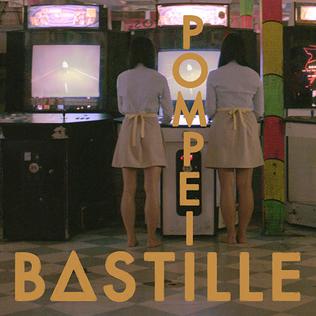 W
W"Pompeii" is a song by British band Bastille. It is the fourth single from their debut studio album Bad Blood and was released on 11 January 2013. The song's title and lyrics refer to the Roman town of the same name that was destroyed and buried in the eruption of Mount Vesuvius in AD 79.
 W
WPompeii: The Last Day is a 2003 dramatized documentary that tells of the eruption of Mount Vesuvius on August 24 79 AD. This eruption covered the Roman cities of Pompeii and Herculaneum in ash and pumice, killing everyone trapped between the volcano and the sea. The documentary, which portrays the different phases of the eruption, was directed by Peter Nicholson and written by Edward Canfor-Dumas.
 W
WThe Roman Mysteries is a series of historical novels for children by Caroline Lawrence. The first book, The Thieves of Ostia, was published in 2001, finishing with The Man from Pomegranate Street, published in 2009, and 17 more novels were planned, plus a number of "mini-mysteries", spin offs and companion titles.
 W
WShadows in Bronze is a 1990 historical mystery crime novel by Lindsey Davis and the second book of the Marcus Didius Falco Mysteries series. Set in Rome, southern Italy, and the Bay of Neapolis during AD 71, just after the year of the four emperors, the novel stars Marcus Didius Falco, informer and imperial agent. The bronze of the title is a statue of a young Helena Justina, Falco's romantic interest.
 W
W"The Variant" is the second episode of the first season of the American television series Loki, based on Marvel Comics featuring the character Loki. It follows an alternate version of the character who cannot return to his own timeline and is now working with the mysterious Time Variance Authority (TVA) to hunt down a fugitive variant of himself. The episode is set in the Marvel Cinematic Universe (MCU), sharing continuity with the films of the franchise. It was written by Elissa Karasik and directed by Kate Herron.
 W
WL'ultimo giorno di Pompei is an opera in two acts composed by Giovanni Pacini to an Italian libretto by Andrea Leone Tottola. It premiered to great success at the Teatro San Carlo in Naples on 19 November 1825 followed by productions in the major opera houses of Italy, Austria, France, and Portugal. When Pacini's popularity declined in the mid-19th century, the opera was all but forgotten until 1996 when it received its first performance in modern times at the Festival della Valle d'Itria in Martina Franca. L'ultimo giorno di Pompei influenced either directly or indirectly several other 19th-century works, most notably Karl Bryullov's 1833 painting, The Last Day of Pompeii.
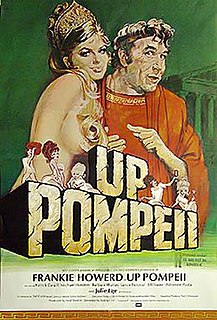 W
WUp Pompeii is a 1971 British sex comedy film directed by Bob Kellett and starring Frankie Howerd and Michael Hordern. The film was shot at Elstree Film Studios, Borehamwood, England and is based on characters that first appeared in the British television sitcom Up Pompeii! (1969–1975).
 W
WUp Pompeii! is a British television comedy series broadcast between 1969 and 1970, starring Frankie Howerd. The first series was written by Talbot Rothwell, a scriptwriter for the Carry On films, and the second series by Rothwell and Sid Colin. Two later specials were transmitted in 1975 and 1991.
 W
WVolcano is the third album by Gatsbys American Dream. The album is also known by the full title printed on the cover, Gatsbys American Dream and the Volcano.